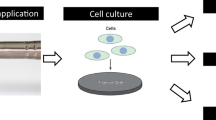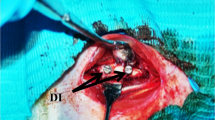Abstract
The surface properties of implant are responsible to provide mechanical stability by creating an intimate bond between the bone and implant; hence, play a major role on osseointegration process. The current study was aimed to measure surface characteristics of titanium modified by a pulsed Nd:YAG laser. The results of this study revealed an optimum density of laser energy (140 Jcm−2), at which improvement of osteointegration process was seen. Significant differences were found between arithmetical mean height (Ra), root mean square deviation (Rq) and texture orientation, all were lower for 140 Jcm−2 samples compared to untreated one. Also it was identified that the surface segments were more uniformly distributed with a more Gaussian distribution for treated samples at 140 Jcm−2. The distribution of texture orientation at high laser density (250 and 300 Jcm−2) were approximately similar to untreated sample. The skewness index that indicates how peaks and valleys are distributed throughout the surface showed a positive value for laser treated samples, compared to untreated one. The surface characterization revealed that Kurtosis index, which tells us how high or flat the surface profile is, for treated sample at 140 Jcm−2 was marginally close to 3 indicating flat peaks and valleys in the surface profile.






Similar content being viewed by others
References
Puleo DA, Nanci A. Understanding and controlling the bone–implant interface. Biomaterials. 1999;20(23):2311–21.
Liu X, Zhang Y, Li S, Wang Y, Sun T, Li Z, et al. Study of a new bone-targeting titanium implant–bone interface. Int J Nanomed. 2016;11:6307–24.
Reviakine I, Jung F, Braune S, Brash JL, Latour R, Gorbet M, et al. Stirred, shaken, or stagnant: what goes on at the blood–biomaterial interface. Blood Rev. 2017;31(1):11–21.
Yang J, Zhou Y, Wei F, Xiao Y. Blood clot formed on rough titanium surface induces early cell recruitment. Clin Oral Implant Res. 2016;27(8):1031–8.
Neuss S, Schneider RK, Tietze L, Knuchel R, Jahnen-Dechent W. Secretion of fibrinolytic enzymes facilitates human mesenchymal stem cell invasion into fibrin clots. Cells Tissues Organs. 2010;191(1):36–46.
Wang Z-S, Feng Z-H, Wu G-F, Bai S-Z, Dong Y, Chen F-M, et al. The use of platelet-rich fibrin combined with periodontal ligament and jaw bone mesenchymal stem cell sheets for periodontal tissue engineering. Sci Rep. 2016;6:28126.
Davies JE. Mechanisms of endosseous integration. Int J Prosthodont. 1998;11(5):391–401.
Davies JE. Bone bonding at natural and biomaterial surfaces. Biomaterials. 2007;28(34):5058–67.
Larsson Wexell C, Shah FA, Ericson L, Matic A, Palmquist A, Thomsen P. Electropolished titanium implants with a mirror-like surface support osseointegration and bone remodelling. Adv Mater Sci Eng. 2016;2016:1750105.
Ting M, Jefferies SR, Xia W, Engqvist H, Suzuki JB. Classification and effects of implant surface modification on the bone: human cell-based in vitro studies. J Oral Implantol. 2017;43(1):58–83.
Van Oirschot BA, Eman RM, Habibovic P, Leeuwenburgh SC, Tahmasebi Z, Weinans H, et al. Osteophilic properties of bone implant surface modifications in a cassette model on a decorticated goat spinal transverse process. Acta Biomater. 2016;37:195–205.
Hotchkiss KM, Reddy GB, Hyzy SL, Schwartz Z, Boyan BD, Olivares-Navarrete R. Titanium surface characteristics, including topography and wettability, alter macrophage activation. Acta Biomater. 2016;31:425–34.
Chen J, Rungsiyakull C, Li W, Chen Y, Swain M, Li Q. Multiscale design of surface morphological gradient for osseointegration. J Mech Behav Biomed Mater. 2013;20(Supplement C):387–97.
Gittens RA, Olivares-Navarrete R, Schwartz Z, Boyan BD. Implant osseointegration and the role of microroughness and nanostructures: lessons for spine implants. Acta Biomater. 2014;10(8):3363–71.
Khosroshahi M, Valanezhad A, Tavakoli J. Evaluation of mid-IR laser radiation effect on 316L stainless steel corrosion resistance in physiological saline. Amir Kabir. 2004;15(58-B):107–15.
Khosroshahi M, Mahmoodi M, Tavakoli J, Tahriri M. Effect of Nd: yttrium–aluminum–garnet laser radiation on Ti6Al4V alloy properties for biomedical applications. J Laser Appl. 2008;20(4):209–17.
Khosroshahi ME, Pour FA, Hadavi M, Mahmoodi M. In situ monitoring the pulse CO2 laser interaction with 316-L stainless steel using acoustical signals and plasma analysis. Appl Surf Sci. 2010;256(24):7421–7.
Bartolomeu F, Sampaio M, Carvalho O, Pinto E, Alves N, Gomes JR, et al. Tribological behavior of Ti6Al4V cellular structures produced by selective laser melting. J Mech Behav Biomed Mater. 2017;69(Supplement C):128–34.
Marin E, Fusi S, Pressacco M, Paussa L, Fedrizzi L. Characterization of cellular solids in Ti6Al4V for orthopaedic implant applications: trabecular titanium. J Mech Behav Biomed Mater. 2010;3(5):373–81.
Khosroshahi ME, Mahmoodi M, Tavakoli J. Characterization of Ti6Al4V implant surface treated by Nd:YAG laser and emery paper for orthopaedic applications. Appl Surf Sci. 2007;253(21):8772–81.
Tavakoli J, Khosroshahi M, Mahmoodi M. Characterization of Nd:YAG laser radiation effects on Ti6A14V physico-chemical properties: an in vivo study. Int J Eng Trans B. 2007;20(1):1.
Khosroshahi ME, Tavakoli J, Mahmoodi M. Analysis of bioadhesivity of osteoblast cells on titanium alloy surface modified by Nd:YAG laser. J Adhes. 2007;83(2):151–72.
Karazisis D, Petronis S, Agheli H, Emanuelsson L, Norlindh B, Johansson A, et al. The influence of controlled surface nanotopography on the early biological events of osseointegration. Acta Biomater. 2017;53:559–71.
Bose S, Tarafder S, Bandyopadhyay A. Effect of chemistry on osteogenesis and angiogenesis towards bone tissue engineering using 3D printed scaffolds. Ann Biomed Eng. 2017;45(1):261–72.
Coelho PG, Granato R, Marin C, Teixeira HS, Suzuki M, Valverde GB, et al. The effect of different implant macrogeometries and surface treatment in early biomechanical fixation: an experimental study in dogs. J Mech Behav Biomed Mater. 2011;4(8):1974–81.
Hamlet SM, Ivanovski S. Inflammatory cytokine response to titanium surface chemistry and topography. In: The immune response to implanted materials and devices. Springer; 2017. p. 151–67.
Coelho PG, Gil LF, Neiva R, Jimbo R, Tovar N, Lilin T, et al. Microrobotized blasting improves the bone-to-textured implant response. A preclinical in vivo biomechanical study. J Mech Behav Biomed Mater. 2016;56(Supplement C):175–82.
Su Y, Komasa S, Li P, Nishizaki M, Chen L, Terada C, et al. Synergistic effect of nanotopography and bioactive ions on peri-implant bone response. Int J Nanomed. 2017;12:925.
Queiroz TP, de Molon RS, Souza FÁ, Margonar R, Thomazini AHA, Guastaldi AC, et al. In vivo evaluation of cp Ti implants with modified surfaces by laser beam with and without hydroxyapatite chemical deposition and without and with thermal treatment: topographic characterization and histomorphometric analysis in rabbits. Clin Oral Investig. 2017;21(2):685–99.
Mangano FG, Pires JT, Shibli JA, Mijiritsky E, Iezzi G, Piattelli A, et al. Early bone response to dual acid-etched and machined dental implants placed in the posterior maxilla: a histologic and histomorphometric human study. Implant dentistry. 2017;26(1):24–9.
Camargo WA, Takemoto S, Hoekstra JW, Leeuwenburgh SC, Jansen JA, van den Beucken JJ, et al. Effect of surface alkali-based treatment of titanium implants on ability to promote in vitro mineralization and in vivo bone formation. Acta Biomater. 2017;57:511–23.
Wirth J, Tahriri M, Khoshroo K, Rasoulianboroujeni M, Dentino AR, Tayebi L. Surface modification of dental implants. In: Biomaterials for oral and dental tissue engineering. Elsevier; 2017. pp. 85–96.
Mangano F, Mangano C, Piattelli A, Iezzi G. Histological evidence of the osseointegration of fractured direct metal laser sintering implants retrieved after 5 years of function. BioMed Res Int. 2017;2017:9732136.
Moore B, Asadi E, Lewis G. Deposition methods for microstructured and nanostructured coatings on metallic bone implants: a review. Adv Mater Sci Eng. 2017;2017:5812907.
Palmquist A, Shah FA, Emanuelsson L, Omar O, Suska F. A technique for evaluating bone ingrowth into 3D printed, porous Ti6Al4V implants accurately using X-ray micro-computed tomography and histomorphometry. Micron. 2017;94:1–8.
Wieland M, Textor M, Spencer ND, Brunette DM. Wavelength-dependent roughness: a quantitative approach to characterizing the topography of rough titanium surfaces. Int J Oral Maxillofac Implants. 2001;16(2):163–81.
Liu J, Fan X, Sun C, Zhu W. Oxidation of the titanium (0001) surface: diffusion processes of oxygen from DFT. RSC Adv. 2016;6(75):71311–8.
Junkar I, Kulkarni M, Drašler B, Rugelj N, Mazare A, Flašker A, et al. Influence of various sterilization procedures on TiO2 nanotubes used for biomedical devices. Bioelectrochemistry. 2016;109:79–86.
Author information
Authors and Affiliations
Corresponding author
Ethics declarations
Conflict of interest
The authors declare that they have no competing interests.
Ethical approval
It is declared that no human or animal has been used at any stage during this experiment.
Rights and permissions
About this article
Cite this article
Tavakoli, J., Khosroshahi, M.E. Surface morphology characterization of laser-induced titanium implants: lesson to enhance osseointegration process. Biomed. Eng. Lett. 8, 249–257 (2018). https://doi.org/10.1007/s13534-018-0063-6
Received:
Revised:
Accepted:
Published:
Issue Date:
DOI: https://doi.org/10.1007/s13534-018-0063-6




